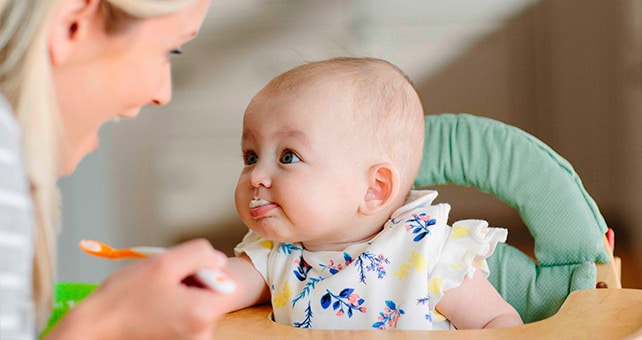Is your baby ready for that first bite of solid food? If so, what food do you offer first? We have the answers, based on guidelines from the American Academy of Pediatrics.
Sources:
"Bite-Sized Milestones: Signs of Solid Food Readiness." HealthyChildren.org. November 21, 2015.
"American Academy of Pediatrics." 2017.
If your baby shows all these signs, they're likely ready to try solids:
- Able to hold up head. Babies should be able to lift their heads and keep them up. This usually happens around three to four months of age.
- Able to sit up. Babies can sit up with the help of some propping, such as in a high chair or infant seat.
- Can move food to the back of their mouths. If babies push the food out of their mouths when you try to feed them, they may not be developmentally ready for solids. They also may just need to get used to the feel of the food in their mouth. Dilute it with breast milk or formula and try again. After a few times, if they still spit it out, try again in a week or two.
- Birth weight has doubled. As a general rule, most babies are able to handle solid foods once they've at least doubled their birth weight and are at least thirteen pounds.
- Eager to try. When babies show interest in the foods others are eating, and open wide when they see food offered, they're saying they're eager to try solids.
If babies show all of these signs, they're likely ready to try solid foods.
Sources:
"Bite-Sized Milestones: Signs of Solid Food Readiness." HealthyChildren.org. November 21, 2015.
"Starting Solid Foods." HealthyChildren.org. March 8, 2017.
Start with:
Single-grain iron-fortified infant cereal, such as rice cereal, is traditionally offered first, but pediatricians now say there's no medical evidence showing it's best to start with one type of food over another. The key is to offer only one new food at a time, then watch your baby for any allergic reactions, such as diarrhea, rash, or vomiting. If this happens, stop feeding your baby that food and talk to your pediatrician. If there are no signs of allergy after two to three days, you can introduce another food.
Source: "Starting Solid Foods." HealthyChildren.org. March 8, 2017.
How much? For the first attempt, start by offering half a spoonful. Your baby may reject it at first. If so, offer a little breast milk or formula, then try again. Continue alternating breast milk or formula with the new food so your baby doesn't become frustrated from hunger.
Source: "Starting Solid Foods." HealthyChildren.org. March 8, 2017.
Find ideas on fruit and veggie purees you can make at home, and more information on which liquids your baby can have and when.
This content is provided for general information purposes only. It is not intended to be a substitute for medical advice or a guarantee of prevention, improvement, or treatment of specific conditions. Always consult with your healthcare provider about your specific medical questions or concerns.

 You are about to leave publix.com and enter the Instacart site that they operate and control. Publix’s delivery and curbside pickup item prices are higher than item prices in physical store locations. Prices are based on data collected in store and are subject to delays and errors. Fees, tips & taxes may apply. Subject to terms & availability. Publix Liquors orders cannot be combined with grocery delivery. Drink Responsibly. Be 21. For prescription delivery, log in to your pharmacy account by using the Publix Pharmacy app or visiting
You are about to leave publix.com and enter the Instacart site that they operate and control. Publix’s delivery and curbside pickup item prices are higher than item prices in physical store locations. Prices are based on data collected in store and are subject to delays and errors. Fees, tips & taxes may apply. Subject to terms & availability. Publix Liquors orders cannot be combined with grocery delivery. Drink Responsibly. Be 21. For prescription delivery, log in to your pharmacy account by using the Publix Pharmacy app or visiting 